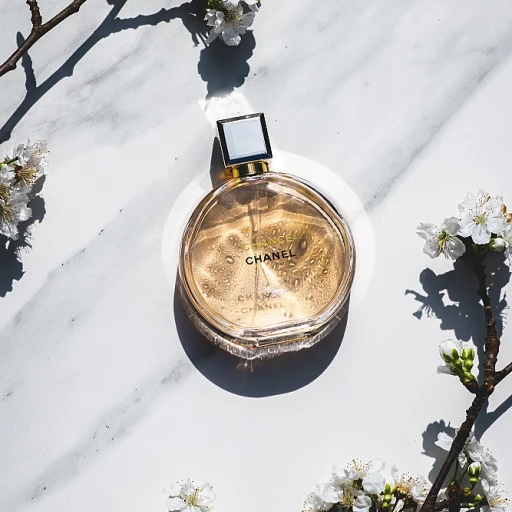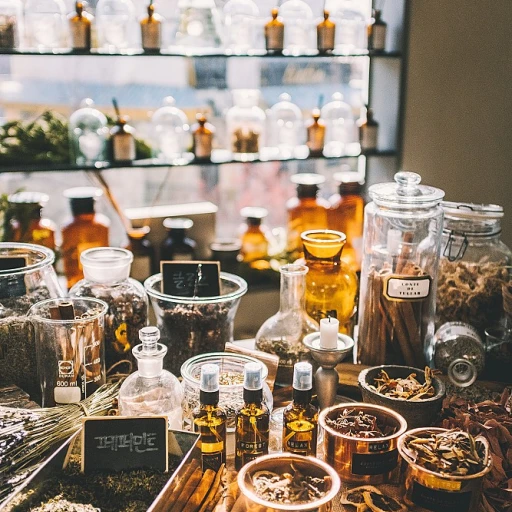
The Rise of Green Perfumery: A Fragrant Revolution
Embracing Eco-Consciousness in the Fragrance Industry
The fragrance industry is undergoing a remarkable transformation, with eco-friendly perfumery at the forefront of this change. Driven by environmentally aware consumers, brands are increasingly embracing green perfumery practices. According to recent statistics, the global market for natural fragrances is expected to grow significantly, indicating a shift towards more eco-conscious production methods. This growth reflects not only a trend but an ideological shift in consumer mindset towards sustainability in scents.
Ingredients that Tell an Eco-Friendly Story
Green perfumery is about more than just the end product; it's a holistic approach that starts with sourcing ingredients responsibly. Leaders in the industry are now exploring ways to ensure that their raw materials do not harm the environment. For example, the use of ethically-harvested essential oils and biodegradable aromatics is becoming a marker of an eco-friendly fragrance. By investing in ingredients that are both kind to the planet and irresistible to the olfactory senses, brands can cater to the 73% of consumers who are willing to pay more for sustainable products, as noted by Nielsen.
Innovative Techniques Redefining Aromatic Creation
Fostering innovation in extraction and distillation methods is also a critical aspect of the green perfumery movement. A notable shift can be seen in the adoption of CO2 extraction and enzymatic processes, which are celebrated for their lower environmental impact. These techniques not only contribute to a reduced ecological footprint but also have the potential to unlock new scent profiles, offering an expanded olfactory palette to discerning consumers.
Case Studies: Champions of the Fragrant Revolution
Looking at the industry's frontrunners, we can see tangible examples of eco-friendly practices in action. Brands that have committed to sustainable sourcing and production often share their journey through transparent reporting, which has become a staple for establishing trust and credibility with fragrance aficionados. From luxury perfume houses to boutique artisanal creators, the fragrance market is abundant with success stories of green transitions. For instance, some perfume brands are now using vetiver from Haiti, where the sourcing of this ingredient supports local communities and helps prevent soil erosion—showcasing how the industry's influence can extend beyond scent creation to social responsibility.
The burgeoning trend of green perfumery does not simply end with the ingredients or the production process. It carries forward into thoughtful packaging design, influenced purchasing choices, and, most importantly, the anticipation of future innovations that will continue to shape the industry. As we explore the implications of these changes, it becomes clear that the fragrance world is not just adapting but leading by example in the realm of sustainable luxury.
Sourcing Scents Sustainably: The Ingredients of Change
Sustainable Ingredients in the Perfume Industry
The perfume industry is witnessing a significant shift towards sustainability, primarily through the sourcing of eco-friendly ingredients. These ingredients are the foundation of green perfumery, representing an area where brands can make a profound impact. According to a market analysis by Grand View Research, the global organic personal care market size, which includes sustainable fragrances, is expected to reach USD 25.11 billion by 2025, expanding at a CAGR of 9.4%. This growth underscores the increasing demand for natural and ethical components in fragrances.
Ethical sourcing efforts are integral to the manufacture of eco-friendly perfumes. Brands are partnering with local communities for the responsible extraction of botanical elements, ensuring fair compensation and environmental stewardship. For example, the essence of vetiver, often sourced from Haiti, is a prime example where ethical practices can enhance the lives of farmers while providing the essence for high-quality scents. Luxury fragrance brands are increasingly spotlighting their commitment to these practices, thereby influencing consumer trust and preference.
Revolutionizing Fragrances with Synthetic Biology
Synthetic biology is revolutionizing the way fragrances are created, with a potential reduction in environmental impact. Startups and established perfumeries alike are utilizing bio-engineered yeasts to produce scent compounds without the need for extensive agriculture, significantly reducing land and water usage. According to a study by Research and Markets, the synthetic biology market is projected to grow from USD 8.84 billion in 2020 to USD 30.7 billion by 2026, which may be attributed to its broad applications, including sustainable fragrance production.
One notable example is the synthesis of ambroxide, a complex aroma molecule traditionally derived from the endangered ambergris. Advances in biotechnology allow for the creation of ambroxide through fermentation, ensuring a steady supply without disrupting marine ecosystems. This practice not only caters to the demand for sustainable alternatives but also paves the way for the creation of novel scents previously unattainable from natural sources.
Circular Economy Approaches to Fragrance Sourcing
The concept of a circular economy is gaining traction in the fragrance world as it emphasizes the reuse and recycling of materials, aligning with eco-friendly objectives. Circular approaches in sourcing aim to reduce waste, extend the lifecycle of raw materials, and create a more sustainable production cycle. As per Circular Economy statistics by Ellen MacArthur Foundation, a circular system could result in a reduction of up to 99% in material use and a 94% cut in carbon dioxide emissions. Implementing these strategies within the fragrance industry could have a substantial positive impact on the environment.
Fragrance houses are exploring the use of byproducts from other industries as raw materials for scents. The reutilization of discarded orange peels from the juice industry to extract citrus oils is a splendid example of this practice. This not only prevents waste but also provides a rich, natural ingredient for perfumers to work with, leading to the creation of deeply nuanced citrus notes in perfumes.
Eco-Design in Packaging: Reducing the Fragrance Footprint
Eco-Design Innovations That Are Changing the Industry
As the perfume industry embraces eco-friendly practices, a significant transformation is unfolding in the realm of fragrance packaging. Experts indicate the sector is on the brink of a major overhaul, with sustainable packaging projected to burgeon. In 2019, the eco-friendly packaging market was valued at approximately $174.7 billion, and it's set to propel to around $249.5 billion by 2025, according to a report from Research and Markets.
Adopting Biodegradable and Recyclable Materials
One of the most impactful strategies for reducing the fragrance footprint is the shift towards biodegradable and recyclable materials. Brands are increasingly substituting traditional plastic and glass for innovative materials such as bamboo, mushroom-based packaging, and bioplastics. This not only minimizes waste but also supports the circular economy.
- Mushroom-Based Packaging: Harnessing the power of mycelium, companies are crafting packaging that disintegrates post-use, leaving zero waste.
- Bamboo: Notably renewable, bamboo is becoming a favorite for its minimal environmental impact and compostable properties.
- Refillable Bottles: Spearheading the refill trend, global brands are offering luxe, durable perfume bottles, promising longevity and waste reduction.
Printing and Production: The Low-Impact Shift
Another facet of sustainable perfume packaging is the evolution in printing and production techniques. Brands are now employing soy-based inks and energy-efficient manufacturing processes. This push towards sustainability can significantly decrease the ecological footprint of perfume production, leading to a drastic 30% reduction in carbon emissions compared to traditional petroleum-based ink production, as per the Soy Ink Information Center.
The Allure of Minimalism in Design
Embracing minimalism is not just an aesthetic preference but a strategic approach within eco-friendly perfumery. Simplified packaging means fewer materials and reduced waste. Moreover, such commitment to sustainability resonates deeply with the 67% of consumers who prefer eco-conscious brands, according to a 2020 Nielsen report.
The Consumer's Role: Purchasing Power and Perfume Preferences
The Influence of Informed Buyers in Eco-Friendly Fragrance Market
As our society becomes more environmentally conscious, the role of the consumer in the world of eco-friendly perfumery grows increasingly vital. Recent studies suggest that over 60% of consumers are willing to pay more for products with a positive environmental impact. This purchasing power has been a significant driving force behind the rise of green perfumery, as consumers actively seek out sustainable and ethically sourced scents. The trend towards ingredients that tell a "green story" is not just about personal preference, but also about the larger impact that these choices can have on the environment.
Moreover, the fragrance industry is witnessing a seismic shift in consumer behavior, with a rising penchant for transparency in ingredient sourcing. Individuals who adore fragrance are now scrutinizing product labels to ensure they are void of harmful chemicals and are sourced responsibly. This shift in consumer expectations fuels a broader transformation in how perfumes are formulated and presented to the market.
Statistics highlight that eco-conscious consumers put sustainability at the forefront when selecting fragrances. A recent survey found that nearly 70% of perfume lovers expressed a preference for fragrances housed in recyclable packaging over those that are not. The clamor for recyclable and minimalist packaging is a clear indicator of the value placed on reducing the environmental impact of their scent arsenals.
- Expanding fragrance wardrobe with eco-conscious choices
- Prioritizing perfume products with natural, biodegradable ingredients
- Supporting brands that engage in fair trade practices
Engaging with Brands: A Synergy between Producer and Consumer
In this fragrant revolution, engaging with brands has become synonymous with advocacy for sustainable practices. Perfume aficionados are no longer passive players in the marketplace; rather, they take an active stance by supporting those brands that align with their eco-friendly values. They understand that by choosing to buy from environmentally responsible brands, they are making a statement about the importance of sustainability in the fragrance industry, and more importantly, across all consumer goods.
By leveraging their influence, consumers send a powerful message: sustainability is no longer a niche interest but has become a mainstream demand. Consequently, brands are responding with a new wave of fragrances that boast eco-friendly credentials, from the use of renewable resources to investments in local communities. As consumers become more curious about the lifecycle of their fragrance products, from inception to disposal, their choices are shaping a more sustainable fragrance industry.
The conscientious perfume buyer's quest often extends beyond the product itself to the ethos of the brand. In the digital age, access to information enables consumers to hold brands accountable, and many demand proof of sustainability efforts, expecting annual reports and transparency about the path to greener perfumery.
"By demanding sustainability, consumers are the authentic catalysts for change in the perfume industry. Their choices are not just shaping the market today, but also dictating the trends of tomorrow."
Fragrance Futurism: What's Next for Sustainable Scent?
Futuristic Trends in Eco-Friendly Fragrance
As consumers become increasingly environmentally conscious, the fragrance industry is responding with innovative eco-friendly products and practices. A growing body of statistics shows that millennials and Gen Z consumers, in particular, are willing to pay more for sustainable goods, with over 73% indicating a preference for sustainable brands (Nielsen). As a leading analyst, one can foresee the transformation of scent-making into a more sustainable practice, leveraging advancements in biotechnology and green chemistry.
Innovative Synthesis of Fragrance Compounds
The future of fragrances lies in the synthesis of scent compounds that do not harm the environment. The extraction of natural oils and essences, while traditionally desirable for their authenticity, often comes with a high ecological price tag. Innovative companies are turning to biotechnological solutions, creating identical fragrance compounds using eco-friendly processes. Firms like Ginkgo Bioworks are redesigning yeast to produce rose oil without the roses, thus saving vast amounts of water and land (Ginkgo Bioworks).
Perfume Personalization and AI
Another exciting frontier is the personalization of fragrance through Artificial Intelligence (AI). AI can analyze vast datasets of consumer preferences, helping formulators to create bespoke fragrances that cater to individual tastes while maintaining a focus on sustainability. Such technology not only enhances the user experience but also minimizes waste by producing exactly what is needed. Experts predict that AI could contribute to a reduction of up to 30% in inventory waste (Accenture), signaling a more efficient and environmentally conscious industry.
Zero-Waste Movement and Solid Perfumes
The zero-waste movement has paved the way for the rise of solid perfumes. Free from plastic packaging and often made with a minimalistic approach, these compact scent options are gaining popularity. According to market research, the solid perfume sector is expected to see substantial growth, offering a more sustainable option for perfume lovers (Grand View Research). Brands like Lush have been pioneers in this movement, showcasing that luxury and environmental stewardship can go hand in hand.
Sustainable Scent Education and Transparency
Lastly, education and transparency will play critical roles in the future of eco-friendly fragrances. Consumers are demanding more information about the products they purchase, including their environmental impact. This desire for knowledge has led to the development of apps and websites that offer detailed information about perfume ingredients and their sustainability credentials. As the demand for 'clean' and 'green' fragrances grows, the trend for brands to disclose their ingredients and sustainable practices will likely become the norm, rather than the exception.
Thus, the future of sustainable scents is both green and bright. With technological advancements, consumer empowerment, and industry commitment to ecological responsibility, the next chapter of perfumery promises to be as fragrant as it is eco-friendly.







-large-teaser.webp)





